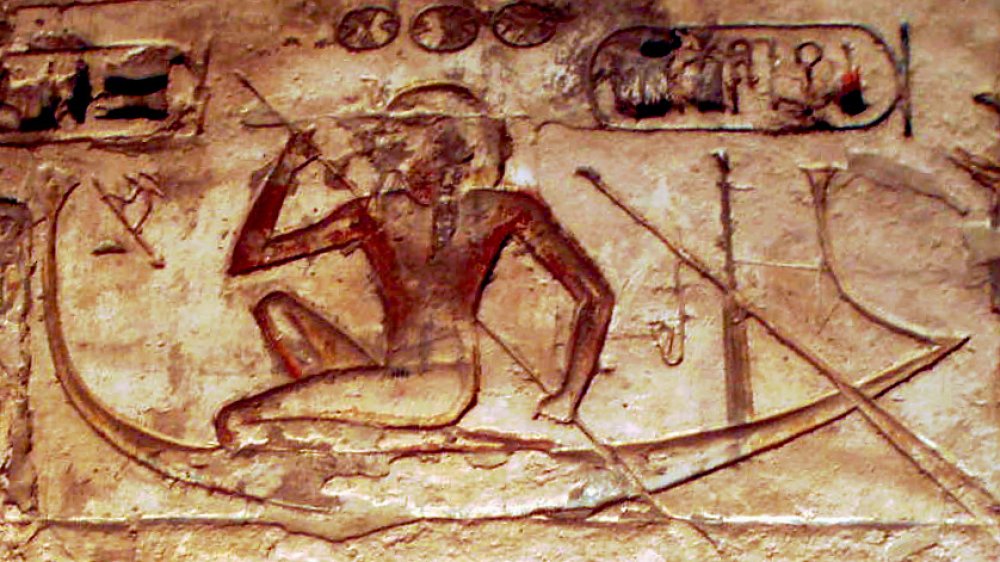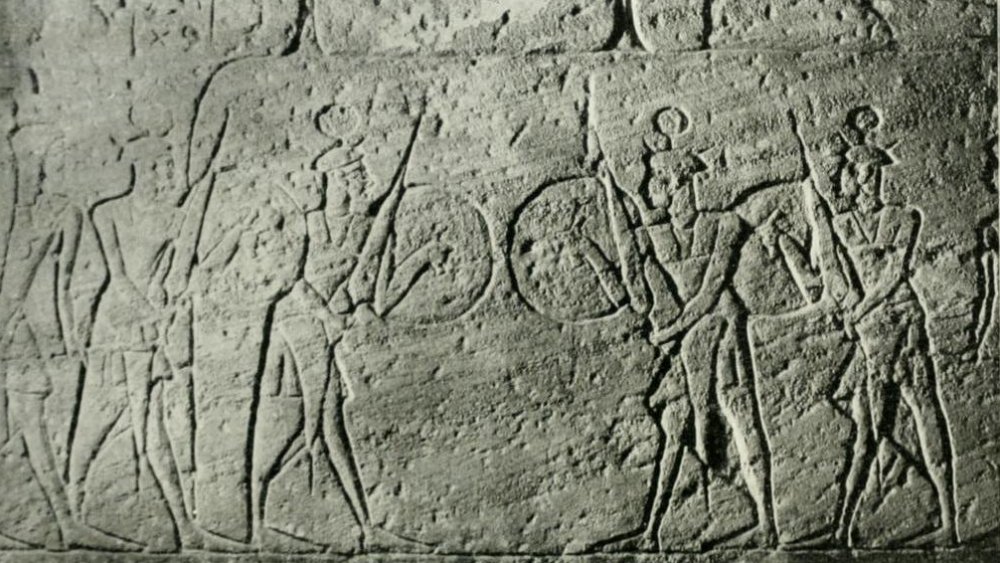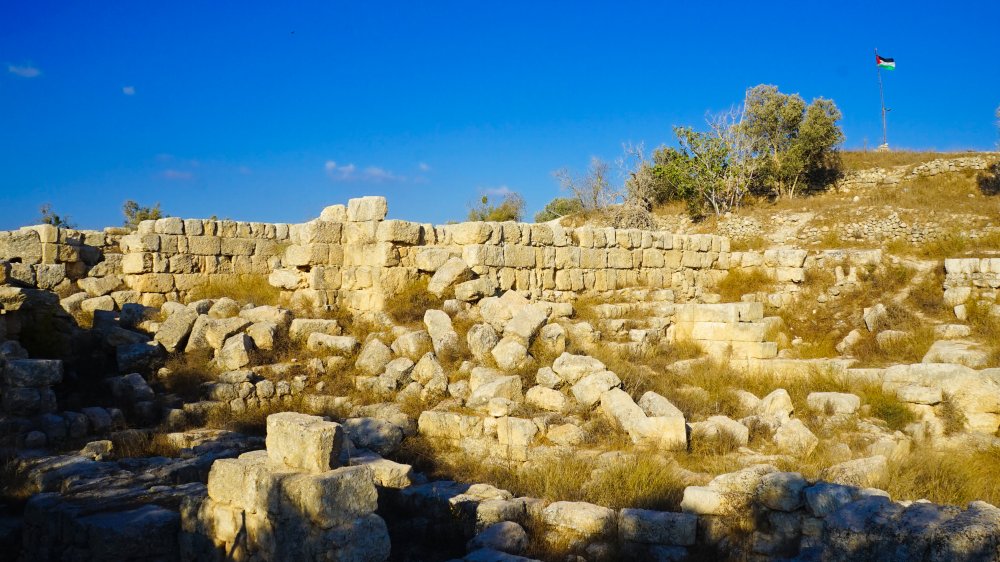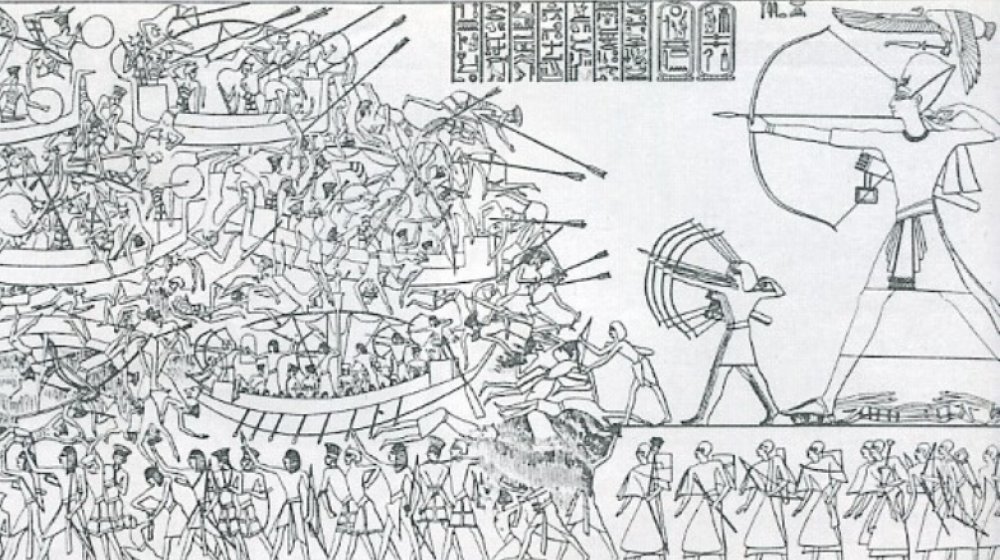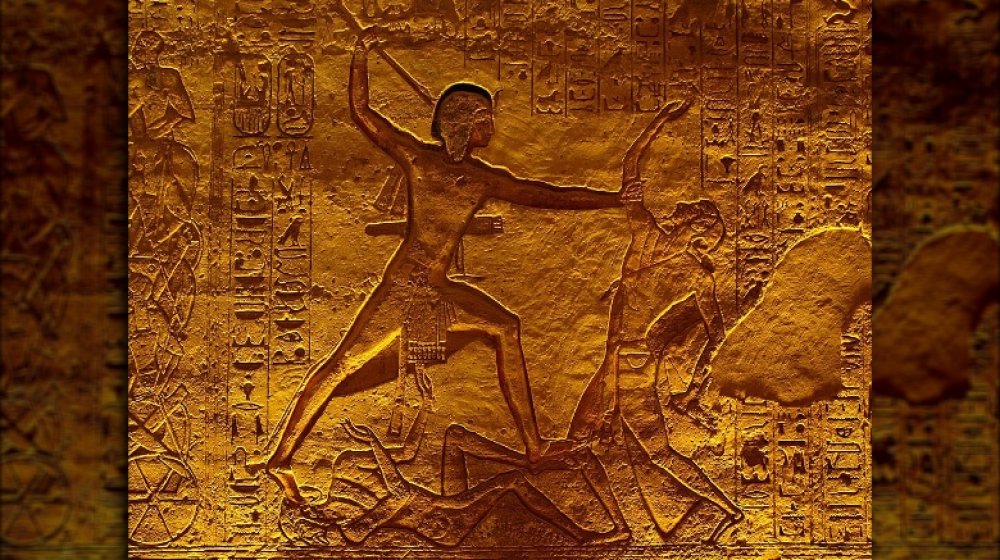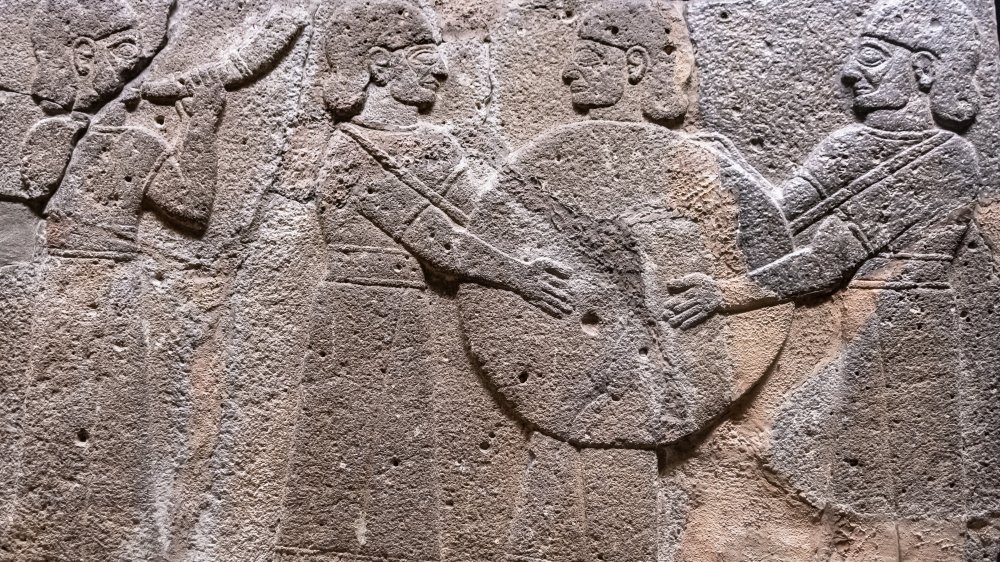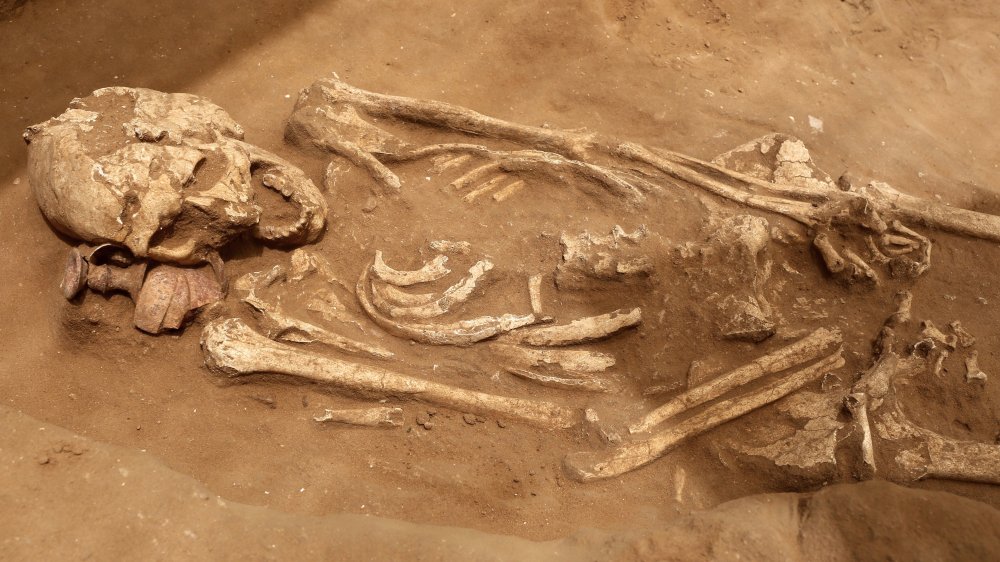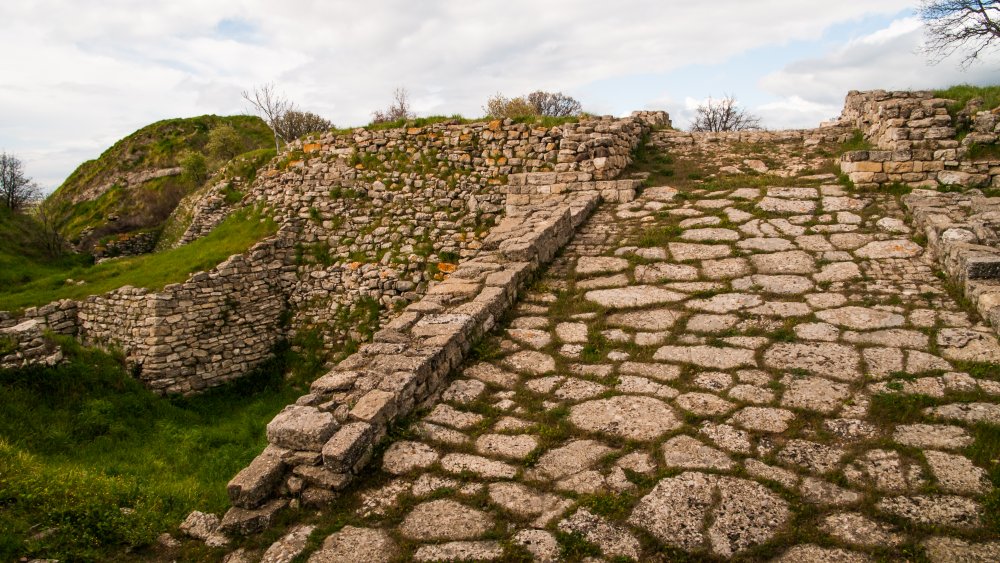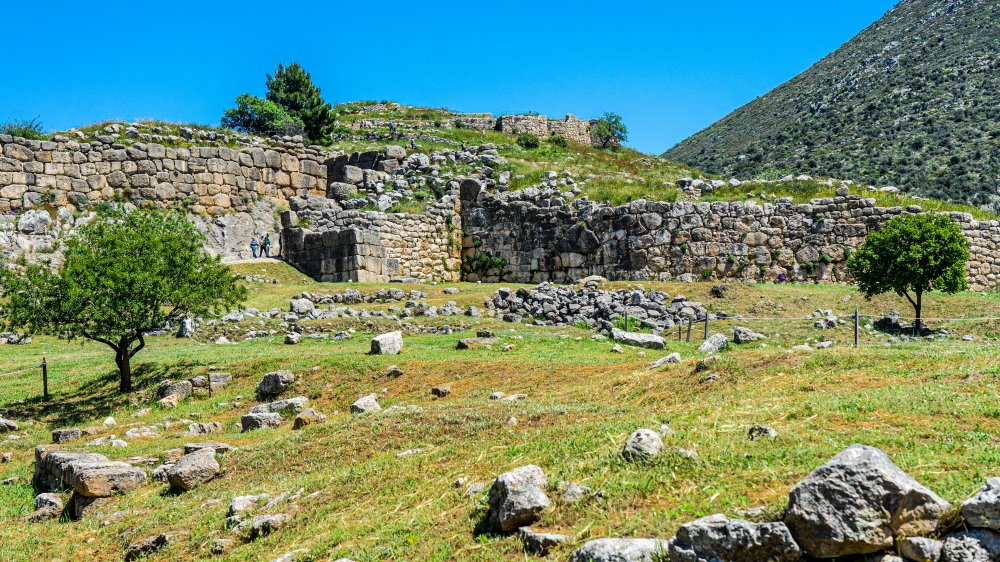The Truth About The Sea Peoples Who Terrorized The Ancient World
"Sea Peoples" sort of sounds like the name for a band of Disney villains, or maybe something you would mail order from the back of a comic book in the 1960s. It doesn't sound much like a fitting moniker for the mysterious group of people that helped bring the Bronze Age to its knees. Maybe if someone dropped the "s" at the end of the name, because seriously, "Sea Peoples" is what a 2-year-old would say while trying to announce the presence of humans on a beach in San Diego.
The Sea Peoples would probably be a bit miffed to learn that today, thousands of years after they terrorized the ancient world, almost no one remembers them. Worse, some people don't think they really existed, and even worse, we think their name is kind of stupid. But the Sea Peoples did exist, and yes their name sounds kind of stupid but that doesn't actually diminish the part where they literally destroyed civilization. So here's the truth about the Sea Peoples, those dudes with the stupid name who you probably never heard of until exactly this moment.
No one knows where the Sea Peoples actually came from
The Sea Peoples weren't actually called "the Sea Peoples" in antiquity, so that's a relief. The name was given to them by a 19th-century Egyptologist who noted that most ancient sources rather generically referred to naval marauders who were "from the sea," without actually being specific about which sea or what lands they'd specifically come from.
In their own time, the Sea Peoples were called other things — according to The Ancient History Encyclopedia, various sources refer to them as the Sherden, the Tursha, the Lukka, the Sheklesh, or the Akawasha, none of which are especially helpful. The most famous description of the Sea Peoples and their origins reads like this: "They came from the sea in their warships and none could stand against them." Also not especially helpful. Other ancient sources note that the Sea Peoples came from the north, which basically rules out most of Africa and opens up all of Europe as a potential Sea Peoples homeland.
There are a lot of theories about who the Sea Peoples were — some historians think they were Etruscan or Italian, some think Philistine, and others think they may have been Minoan. But those are all just theories. Unless archaeologists one day uncover some hidden text that includes MapQuest directions to the Sea Peoples' homeland, we'll probably never be able to do much more than guess.
The Sea Peoples were some seriously not-cool peoples
Once upon a time, the Mediterranean was a land of prosperity. In the 2,000 years before 1200 BC, merchants were making a tidy living along the coast and on land and everyone was eating olives and drinking wine and congratulating each other on all the prosperity. And then the Sea Peoples had to show up and wreck it all. They attacked Egypt from the north, they harassed the Hittites and the Phoenicians (who lived in what is now Turkey, Syria, and Lebanon) and they made life really difficult in Crete and Cyprus. At one point they even allied with the Libyans prior to invading Egypt, so it's not like they were super mysterious in their own time or anything.
According to San Jose State University, Egypt eventually allowed the Sea Peoples to settle in what is now Israel and Palestine, so although we don't know where they came from, we do know where at least some of them ended up. And still, no one bothered to make note in the historical record about who they were and where they came from, which does give historians lots of things to disagree about but otherwise seems like a pretty major historical oversight.
A lot of what we know about the Sea Peoples comes from a single source
For a group that had such a profound influence on a fairly large portion of civilization, there is surprisingly little information about the Sea Peoples in the historical record. It's not just the total lack of an origin story, it's also a near-absence of other details. In fact according to San Jose State University, the major source of Sea Peoples dirt comes from one place: a set of carved scenes on a stone wall at Ramesses III's mortuary temple of Medinet Habu on the west bank of the Nile. The carvings appear to be a pictorial record of a Sea Peoples defeat — in one section, there's a naval battle, in another, a land battle, and in a third, the Sea Peoples have been captured. From that, we have some details about things like what they looked like, what weapons and armor they used in battle, and what their warships were like.
We can also discern that they were likely not a single group of people. The hieroglyphics that appear alongside the carvings list multiple names for the various Sea Peoples who participated in the battle, but none of the information actually helps historians arrive at conclusions about who exactly each of those groups was. So we've got pictures and names, but whatever. We've got pictures and names of lots of Hollywood celebrities, too, but that doesn't mean we're any closer to understanding them.
A small wooden model sort of tells us what Sea Peoples' ships looked like
You can only tell so much about history from a picture someone chiseled into a wall. If you could believe everything you saw chiseled into a wall, then you would know that lots of Egyptians had animal heads and falcons wore hats.
For real information, you have to go three dimensional. Ideally, it would be cool if someone would just dig up an actual Sea Peoples ship, but so far the best we've got is a late 13th century (or possibly 12th century) wooden model of a Sea Peoples ship. According to the Liberal Arts department at Texas A&M University, the model was found in a tomb at Gurob, and is an example of the type of ship the Sea Peoples were known to have used, based on what we've been able to glean from the carvings on Ramesses III's mortuary temple.
The Gurob model has wheels, which makes it easy to mistake for a toy. But historians think the wheels might reflect the design of a "land-based cultic ship," or a cart that was designed to look like a Sea Peoples vessel. Either way, the ship design replicated by the Gurob model was not just something the Sea Peoples used to terrorize the ancient world — the design also heavily influenced many of the naval vessels that came after it, and in fact may have been one of history's most important ship designs.
It never occurred to anyone that they should write down the Sea Peoples' identity
Okay, so why didn't someone, somewhere, write down the identities of these terrifying naval marauders? To truly comprehend how this could happen, let's just put it in a modern context. Let's say Canada decided to invade the United States. When discussing the invasion, most journalists would refer to the Canadian army, maybe to the generals and certainly to that oddly handsome dude who's running everything up there. What journalists wouldn't say is something like, "Canada is a country in the northern region of North America, which stretches from the northern border of the United States into the Arctic circle in the north, and east to the Atlantic and west to the Pacific." Why wouldn't anyone say that? Because everyone knows where Canada is and it would be ridiculous for journalists to try to explain it every time they mentioned the Canadian invaders.
Likewise, ancient historians also didn't feel like they needed to make note of their enemies' hereditary identity. According to Sea Peoples of the Bronze Age c. 1400 BC-1000 BC, the identity of the Sea Peoples and the location of their homeland was likely known to the ancient Egyptians, so why write something that obvious down? No one was thinking in terms of all the poor historians from the 21st century who would spend whole careers tirelessly debating the origins of the people that your whole country is already painfully familiar with.
The Sea Peoples seriously had it in for Egypt
The Sea Peoples attacked a lot of cities and settlements along the Mediterranean, but they had an especial affinity for attacking Egypt. In fact, in total they harassed three different pharaohs, beginning with Ramesses II, then moving on to his son and successor Merneptah, and then finally fighting battles against Ramesses III. In Ramesses II's time, the Egyptian account of the Sea Peoples says they were allies of the Hittites, who were driven from the Egyptian trade center of Kadesh by Ramesses' army in 1274 BC. But according to the Ancient History Encyclopedia, the Sea Peoples were also mercenaries and some of them fought in Ramesses' own army, too.
Ramesses II's history suggests he pretty much trounced the Sea Peoples, annihilating them in a naval battle and then pressing some of the survivors into service as his bodyguards. That Ramesses seemed confident that the Sea Peoples were over, but Merneptah found out the hard way how wrong his dad had been. This time the Sea Peoples teamed up with the Libyans and invaded the Nile Delta. Merneptah defeated them, too, but the dudes were pretty relentless. They were back again for the reign of Ramesses III, destroying the trade center of Kadesh and attempting yet another invasion of Egypt. Ramesses defeated them in 1180 BC but they came back, and he had to defeat them again in 1178 BC.
The Sea Peoples destroyed the Hittite empire and contributed to the fall of the Mycenaeans
Around 1200 BC, which was 74 years after the Sea Peoples and the Hittites banded together to take over the Egyptian trade center of Kadesh in the time of Ramesses II, the Sea Peoples decided that shared history really didn't mean much and that they should just annihilate the Hittites because why the heck not. According to the Ancient History Encyclopedia, the Sea Peoples launched a bunch of attacks all along the area now known as Asia Minor, damaging the Hittite Empire to the point where it was unable to recover.
But that's not all. The Sea Peoples also obliterated the Mycenaeans, who up until that point had dominated most of mainland Greece and many of the surrounding islands. The Mycenaeans controlled the Aegean Sea and the Sea Peoples, being Sea Peoples, couldn't have that, so they sent ships to attack Mycenaean strongholds, destroying many of the coastal towns on the Greek islands and mainland. The attacks may not have been solely responsible for the fall of the Mycenaeans — there were also some other crappy things happening in the region at that time, including volcanic eruptions, tsunamis, earthquakes, political unrest, overpopulation, and climate change, so it's almost like the universe kind of didn't like the Mycenaeans anyway. Whatever the case, attacks by the Sea Peoples certainly contributed to the fall of the Mycenaeans, so great job Sea Peoples. Nice going.
But who were the Sea Peoples, really?
Everyone who has a passing interest in Bronze Age history has a theory about who the Sea Peoples were, but up until recently none of those theories had a lot of substance to back them up. One possible exception is some 2019 DNA research that might link the remains of 10 skeletons to the Sea Peoples. According to Newsweek, these individuals lived in the port city of Ashkelon somewhere between 3,000 and 3,500 years ago, which was around the same time that the Sea Peoples were terrorizing the Mediterranean. These particular skeletons were unique because they carried genes from Southern Europe, which is not something researchers tend to find in individuals who lived in the area during later periods.
Okay so here's where the link gets a little tenuous — in theory, the 10 individuals in the study were early Philistines, since their presence in Ashkelon corresponds to the arrival of the Philistines around the beginning of the Iron Age. And some historians think, based on their interpretations of ancient texts, that the Philistines belonged to one of the many groups of Sea Peoples. But that's pretty much all they've got, and frankly, it's not super-convincing. "From the genetics, we cannot determine whether these ancestors of the Philistines that migrated to Ashkelon were indeed part of the Sea Peoples or not," said study leader Michal Feldman. In other words, we're not really any closer to an answer.
Beware of Sea Peoples bearing gifts
Unless you were seriously not paying attention in your high school world history class, you know there was a World War I and you know there was a World War II. But did you know that there was also a World War Zero? And it didn't have zombies or anything.
Actually there was a World War Zero according to just one dude — an archaeologist named Eberhard Zangger, who says the Sea Peoples weren't just responsible for annoying the Egyptians and wrecking everything for the Hittites and the Mycenaeans, they were responsible for the world's first major international conflict. According to New Scientist, one of the key battles of World War Zero was the battle of Troy, which you may remember from such ancient texts as Homer's Iliad — unless of course you were seriously not paying attention in your high school literature class, too.
The idea that the Sea Peoples were so badass that they engaged in international warfare like 3,000+ years before it actually became a thing is pretty cool, but most archaeologists think the theory is far-fetched. In fact a lot of archaeologists think most of what we know about Troy and the Trojan war is far-fetched, too, so until we get our facts straight it might be amusing to think the Sea Peoples brought down Troy — it's just more likely to be fiction than fact.
The Sea Peoples traveled with pigs
Okay so we know almost nothing about the Sea Peoples, but we do know this one weird thing. We know that the Sea Peoples traveled with pigs. Because in the grand scheme of important archaeological discoveries, well, what could be more important than learning all about what kind of poop this mysterious band of marauders was stepping in all the time.
Yes, according to Haaretz, in 2017 researchers announced that at least some of the Sea Peoples traveled with their swine. How do we know this? Because scientists were able to do a genetic analysis of pig bones from sites in Israel and the Aegean, and from that they learned the pigs were world travelers. Or more accurately, that they frequently crossed seas and were bred with local pigs, which really can only mean one thing: Humans brought them. So that's fascinating but even more fascinating is the fact that we can't trace the origin story of an entire race of conquerors, but we can trace the origin story of a bunch of dead pigs. Yay, science.
The Sea Peoples didn't just take down civilizations, they took down an entire age
Some conquerors can say they took down whole civilizations, but when that happens the invaders/conquerors usually replace those civilizations with their own. Well, that's not what the Sea Peoples did. They may have had the intention to move in and take over but in most cases that's not what happened.
According to the Ancient History Encyclopedia, between 1250 BC and 1150 BC, cities all over the Mediterranean began to fall, and their civilizations fell with them. Writing systems were abandoned, trade relations were abolished, and loads of people died. Even the Egyptians, who had actually defeated the Sea Peoples, were too weakened to survive the experience. Their civilization collapsed during the reign of Ramesses VI, less than 50 years after the last encounter between Egypt and the Sea Peoples. After the Bronze Age ended, a new dark age began — these were the early days of the Iron Age, when everyone had to kind of start from scratch and try to rebuild everything so it was bigger and better.
Now, the Sea Peoples were likely not the sole contributing factor to the collapse of the Bronze Age, but most historians agree that they played a role. They might even have invaded out of necessity — perhaps natural disasters had displaced them from their homelands, which is why they were out marauding and being badasses in the first place.
Here's what happened to the Sea Peoples in the end
Sorry to get your hopes up, but we don't know what happened to the Sea Peoples in the end because they vanished from the historical record just as mysteriously as they appeared. There are no further accounts of them after that last conflict with Ramesses III in 1178 BC.
Why did ancient historians not bother to note what became of them? Maybe for the same reason they didn't bother to note where they came from. It was common knowledge, a story that everyone was telling, and maybe it just felt redundant to write it all down. Or maybe the Sea Peoples didn't actually disappear at all — the Ancient History Encyclopedia suggests that they might not have gone back to where they came from — perhaps the survivors of the conflict remained in Egypt and were assimilated into the culture over time, eventually losing their identities and genetic distinction. That's the kind of gradual change that isn't likely to make the history books because it would make for seriously boring reading (Bob assimilated with Karen, Bob and Karen beget Bethany, who assimilated with Justin ... Yeah let's just not read that textbook.)
So for all their modern mystery, it's quite likely that the brilliantly antagonistic Sea Peoples just didn't have much of an ending tale to go with the origin story they also didn't have much of. Oh well, mysteries are more fun anyway.
